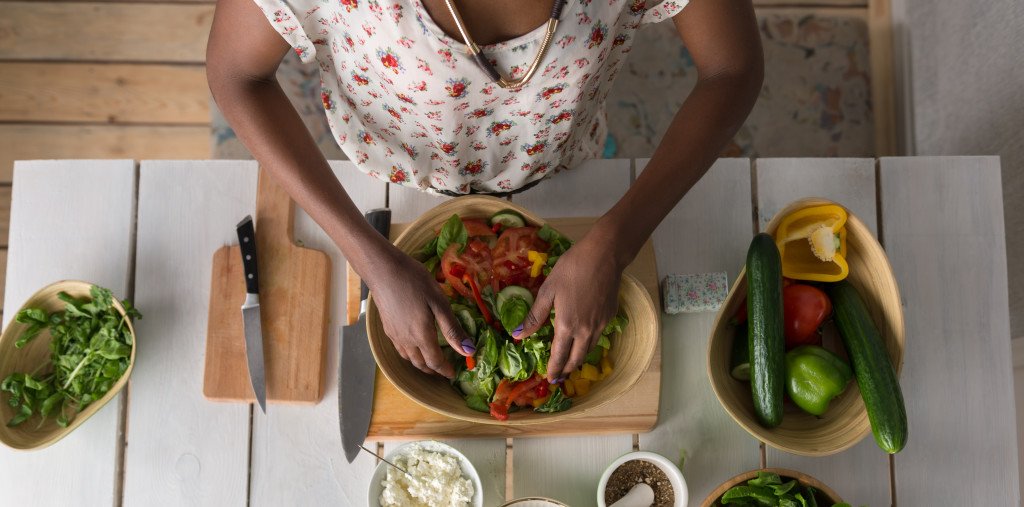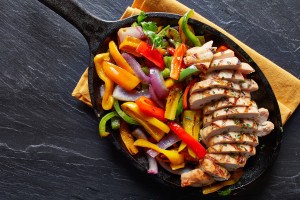Eating to control your weight and your blood sugar
The Mediterranean-style low carb diet approach, which we recommend in The Blood Sugar Diet, is a low sugar diet, low in starchy, easily digestible carbs, but packed full of disease-fighting vitamins and flavonoids. It is rich in olive oil, fish, nuts, fruit and vegetables, but also contains lots of lovely things that down the years we have been told not to eat, such as full fat yoghurt and eggs.
Although it is derived from the eating habits of people living in Mediterranean countries, you can apply the principles of Med-style low carb diet eating to a wide range of different cuisines, from Chinese or Indian through to Mexican or Scandanavian.

There is extensive evidence for the benefit of the Mediterranean style low carb diet, including cutting your risk of heart disease and diabetes. It has even been found to reduce risk the risk of breast cancer, compared with those on a low-fat diet. Consuming extra virgin olive oil (the fresh squeezed juice of olives) seems to be particularly beneficial when it comes to cancer, perhaps because it contains compounds such as polyphenols which are known to be anti-inflammatory.
“This is potentially a life changing book for people with raised blood sugar levels as well as those with type 2 diabetes”
Dr Tim Spector, Professor of Genetics, Kings College, London
Kick the Carbs: Mediterranean Style Low Carb Diet Eating – The ‘M Plan’
Cut right down on sugar, sugary treats, drinks and desserts: No more than once or twice a week and preferably less. You can use sugar substitutes like stevia and xylitol, but try to wean yourself off your sweet tooth.
Avoid sweet fruits: Berries, apples & pears are fine, but sweet tropical fruits such as mango, pineapple, melon and bananas are full of sugar.
Minimise or avoid the starchy “white stuff” bread, pasta, potatoes, rice: Be wary of “brown” alternatives: the extra fibre can be negligible. Brown rice is OK, but some wholemeal breads have added sugar. Switch instead to quinoa, bulgur (cracked wheat), whole rye, whole-grain barley, wild rice and buckwheat.
Avoid most breakfast cereals: They are usually full of sugar, even the ones that contain bran. Oats are good as long as they are not the instant sort.
Avoid snacking if possible find healthy snacks if you must: Nuts are a great source of protein and fibre. Try to avoid salted or sweetened nuts, which can be moreish. Or a few bits of chopped veg, a small amount of dark chocolate after meals (70% or more)

Start the day with eggs: Boiled, poached, scrambled or as an omelette – they’ll keep you fuller for longer than cereal or toast. Delicious with smoked salmon and a sprinkle of chilli.
Full-fat yoghurt is also good: Add berries, like blackberries, strawberries or blueberries, for flavour. Or a sprinkling of nuts.
Eat more healthy fats and oils: Along with oily fish (salmon, tuna, mackerel), consume more olive oil. A splash makes vegetables taste better and improves the absorption of vitamins. Use olive, rapeseed or coconut oil for cooking.
Legumes, such as lentils and kidney beans: Healthy and filling.
Use butter instead of margarine: Cheese in moderation is fine.
 Have high-quality proteins: Oily fish, prawns, chicken, turkey, pork, beef and, of course, eggs. Other protein-rich foods: soya, edamame beans, Quorn, hummus. Processed meats (bacon, salami, sausages) should be eaten only a few times a week.
Have high-quality proteins: Oily fish, prawns, chicken, turkey, pork, beef and, of course, eggs. Other protein-rich foods: soya, edamame beans, Quorn, hummus. Processed meats (bacon, salami, sausages) should be eaten only a few times a week.
Eat plenty of different coloured veg: From dark leafy greens to bright-red and yellow peppers.
Add sauces and flavouring to your veg: Lemon, butter or olive oil, salt, pepper, garlic, chilli, gravy.
Have a drink, but not too many: Once you are on the ‘maintenance’ BSD Way of Life, try to average no more than one to two units a day (a small glass of wine or shot of spirits is 1.5 units) and cut back on beer – it’s rich in carbs, which is why it’s known as “liquid toast”.
Fibre is good: the Mediterranean low carb diet does not mean no carbs at all. Not only is this very hard to achieve, but can be detrimental. This is why complex carbs and fibre are still important and can easily be gained from food such as nuts, legumes and lentils
(We recommend no alcohol for the first month of the diet: this helps the liver kick back into function and to reduce insulin resistance. Drinking is also likely to undermine your will to succeed)
Bring back healthy fats
They keep you full for longer as they are digested slowly, have minimal impact on blood sugar and can make food taste better. The low carb diet allows you to eat a higher fat diet.
Dairy products are back in: Recent research has found that these do not cause diabetes. They are a good source of calcium and protein. They also help you feel fuller for longer. Eat in moderation as they are fairly high in calories. A scattering of grated cheese can be used on baked vegetables to add flavour. A bit of parmesan on broccoli…
Eggs: Forget the idea that cholesterol turns into damaging cholesterol in your arteries and blood…Eggs have been reinstated as a healthy & filling source of protein. Especially good for a quick breakfast – go to work on an egg or two.
 Healthy fats & oils are back in too: Eating fat does not automatically clog the blood vessels in the way that poring oil down the drain will eventually block the drain. You make your own cholesterol and lipids and are more likely to increase your levels of the more damaging Very Low Density Lipoprotein (VLD), which is made in the liver when you eat a high carbohydrate diet.
Healthy fats & oils are back in too: Eating fat does not automatically clog the blood vessels in the way that poring oil down the drain will eventually block the drain. You make your own cholesterol and lipids and are more likely to increase your levels of the more damaging Very Low Density Lipoprotein (VLD), which is made in the liver when you eat a high carbohydrate diet.
Although oil or butter is high in calories, it is very slowly digested and surprisingly does not significantly increase your blood sugar. It makes vegetables taste better and can improve the absorption of certain vitamins and the essential vitamins A, D, E & K are only found in certain fats & oils. Avoid foods containing trans-fats (usually processed foods). Use oils such as olive oil, rapeseed oil or coconut oil. It also helps you feel full for longer so be more generous
Nuts are also included: They provide a good source of protein, minerals & vitamins, contain healthy fats and have a high fibre content. You nibble them, chuck them in salad or stews. They make a good low carb diet alternative to flour for baking by using almond or coconut flour.

8 Tips to help the med style low carb diet work on your blood sugar
- Aim for variety and to eat plenty of green and non starchy vegetables. Keep trying new things to maintain interest and nutritional balance.
- Soups are surprisingly satiating, cheap & practical. You can take them to work for lunch, keep portions in the freezer and they are more slowly digested. Use lots non-starchy veg or clear soups, like Miso soup.
- Use grated cauliflower instead of rice or mash it instead of potato. Much lower calorie & fewer carbs. Cook/steam the ‘rice’ for a few minutes only.
- You may need to increase your water intake when you reduce carbohydrates.
- Beware hidden calories in drinks. Alcohol is surprisingly high calorie and avoid if possible. Other liquid calories include fruit juice, smoothies & cordials
- Avoid ‘Diet’ products. They often contain sugar and/or sweeteners (which may not switch off hunger signals).
- Exercise reduces appetite. It is good for general cardiovascular fitness and strength, but is a hard way to lose weight. If you find it hard to exercise, simply moving more has significant health benefits and can increase your metabolic rate. Get up and move around every half hour, walk don’t take the bus, stairs instead of lift…Get a pedometer and try to increase your steps by 10% each week.
- Use flavour enhancers so each meal is as tasty as possible. Lemon, pepper, lime, chilli, garlic, gherkins, mustard, herbs add loads of flavour but very few calories.
You may crave carbs at first, but most people find this settles within a matter of days. As your insulin resistance drops so does your appetite. In fact most people feel better & find they have more energy.
If you are also cutting calories by doing the BSD fast 800 or the BSD 5:2, these principles work for fast days and non-fast days, but we ask you only to count the calories on the fasting days.
You can adapt your usual diet and make healthy swaps, but it may also be helpful to try some new recipes to make sure you get a good nutritional balance. See some suggestions and share your tips in the recipe section.
There are some delicious and easy to prepare suggestions and a full 1 month plan for the intensive BSD Fast 800 in the Blood Sugar Diet book. For the latest science around low carb diet eating and to find out the best approach for you – go to thefast800.com.
